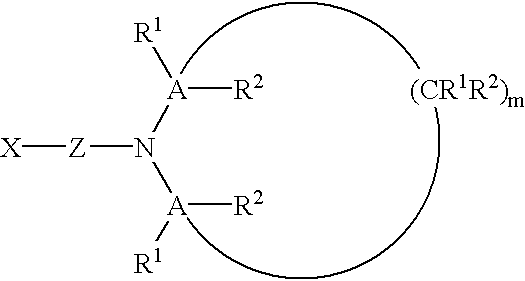Hetero-telechelic polymers and processes for making same
a technology of heterotelechelic polymers and polymers, applied in the field of new materials, can solve the problem that the dilithium approach cannot afford telechelic polymers, and achieve the effect of wide range of useful physical properties
- Summary
- Abstract
- Description
- Claims
- Application Information
AI Technical Summary
Problems solved by technology
Method used
Image
Examples
example a
Preparation of 3-(t-Butyldimethylsilyloxy)-1-Propyllithium Chain Extended with 2 Moles of Isoprene
[0083] A 500 ml, three-necked Morton flask was equipped with a mechanical stirrer, a 125 ml pressure-equalizing addition funnel, and a Claisen adapter fitted with a thermocouple, a reflux condenser, and an argon inlet. This apparatus was dried in an oven overnight at 125.degree. C., assembled hot, and allowed to cool to room temperature in a stream of argon. Lithium dispersion was washed free of mineral oil with hexane (2.times.70 ml), and pentane (1.times.70 ml), then dried in a stream of argon. The dry dispersion, 5.20 grams (0.749 mole, 2.80 equivalents) was transferred to the flask with 260 ml cyclohexane. This suspension was stirred at 450 RPMs, and heated to 65.degree. C. with a heating mantle. The heat source was removed. 1-(t-Butyldimethylsilyloxy)-3-chloro-propane- , 58.82 grams (0.268 mole, 1.00 equivalent) was added dropwise. An exotherm was detected after 31.8% of the feed h...
example b
Preparation of 3-(t-Butyldimethylsilylthio)-1-propyllithium Chain Extended with 2 Moles of Isoprene
[0084] A 500 ml, three-necked Morton flask is equipped with a mechanical stirrer, a 125 ml pressure-equalizing addition funnel, and a Claisen adapter fitted with a thermocouple, a reflux condenser, and an argon inlet. This apparatus is dried in an oven overnight at 125.degree. C., assembled hot, and allowed to cool to room temperature in a stream of argon. Lithium dispersion is washed free of mineral oil with hexane (2.times.70 ml), and pentane (1.times.70 ml), then dried in a stream of argon. The dry dispersion, 5.20 grams (0.749 mole, 2.80 equivalents) is transferred to the flask with 260 ml cyclohexane. This suspension is stirred at 450 RPMs, and heated to 65.degree. C. with a heating mantle. The heat source is removed. 1-(t-Butyldimethylsilylthio)-3-chloro-propane- , 60.22 grams (0.268 mole, 1.00 equivalent) is added dropwise. An exotherm is detected after 21.8% of the feed has bee...
example c
Preparation of 3-(N,N-Dimethylamino)-1-propyllithium Chain Extended with 2 Moles of Isoprene
[0085] A 500 ml, three-necked Morton flask was equipped with a mechanical stirrer, a 125 ml pressure-equalizing addition funnel, and a Claisen adapter fitted with a thermocouple, a reflux condenser, and an argon inlet. This apparatus was dried in an oven overnight at 125.degree. C., assembled hot, and allowed to cool to room temperature in a stream of argon. Lithium dispersion was washed free of mineral oil with hexane (2.times.70 ml), and pentane (1.times.70 ml), then dried in a stream of argon. The dry dispersion, 10.57 grams (1.520 moles) was transferred to the flask with 250 ml cyclohexane. Coarse sand, 45.3 grams, was added to the reaction mixture. This suspension was stirred at 600-675 RPMs, and heated to 37.degree. C. with a heating mantle. The heat source was removed. 1-Chloro-3-(N,N-dimethylamino)propane, 19.64 grams (0.1615 mole) dissolved in 120 ml. Cyclohexane was added dropwise. ...
PUM
| Property | Measurement | Unit |
|---|---|---|
| temperature | aaaaa | aaaaa |
| temperature | aaaaa | aaaaa |
| temperature | aaaaa | aaaaa |
Abstract
Description
Claims
Application Information
 Login to View More
Login to View More - R&D
- Intellectual Property
- Life Sciences
- Materials
- Tech Scout
- Unparalleled Data Quality
- Higher Quality Content
- 60% Fewer Hallucinations
Browse by: Latest US Patents, China's latest patents, Technical Efficacy Thesaurus, Application Domain, Technology Topic, Popular Technical Reports.
© 2025 PatSnap. All rights reserved.Legal|Privacy policy|Modern Slavery Act Transparency Statement|Sitemap|About US| Contact US: help@patsnap.com

